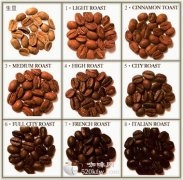A Review of Coffee roasting History in the World
People who have come into contact with coffee will be intoxicated by the charm of coffee, crazy because of the charm of coffee, can not help but unveil the layers of mystery of coffee. Looking for legends about coffee! In particular, the wonderful changes that have taken place after coffee roasting are even more fascinating:
The unique sweetness of coffee
The peculiar fruit acid of coffee
……
So how did coffee become so magical? Looking back in history, we find that:
The earliest roasting tools used by human beings are to roast the hot drum directly with fire and then transfer it to the raw beans in the drum. This is the most primitive way of roasting coffee, which is summed up by some people as direct roasting. Although later, humans invented the motor, which kept turning the drum and stirring the coffee beans in the drum, in an attempt to let each coffee bean touch the hot iron wall evenly, so as to achieve the goal of balanced baking. However, this baking method still has many disadvantages: because the contact surface between iron and coffee is small and the thermal conductivity is not fast, it must take more time to complete the baking; especially on the outside of the burning drum, the heat dissipates in the air, which wastes a lot of energy, which is a great pity; moreover, when the raw bean touches the inner wall of the drum for too long, it is easy to be scorched, resulting in bitterness and scorching taste. Of course, when baking, there are a lot of debris burst out, left in the tube is easy to adhere to the surface of coffee beans, will make the flavor become chaotic, making the baker feel very helpless.
Between 1870 and 1920, the German Fan Guban improved and built the barrel roaster. He brought hot air into the roasted coffee beans. In 1907, the German Perfekt roaster began to introduce this concept, using gas heating, there is an air pump, half of the hot air into the drum, half to the outer barbecue drum, some people summed up as semi-hot air direct baking. Up to now, roller baking in Germany is still widely used, and the Probat drum baking machine in that country is a representative. The general roaster uses gas or electricity as the heat source. Derek Company of Idaho took the lead in using the infrared heat source activated by gas in 1987 to control the temperature more accurately and became the first brand in North America. Today's drum roasters are almost all semi-hot air direct fire type, on the one hand directly heat the drum with the fire source, on the other hand bring the hot air into the drum. The hot air blown into the drum can increase the heating speed and blow away the debris, thus producing balanced and clean coffee beans.
Founded in Italy in 1918, LILLA, which moved to Brazil in World War I, successfully developed the most perfect hot air convection heating roaster in the world, that is, through suction, the air forced to penetrate the coffee roasting room, so that coffee beans can get the best roasting effect in all directions and become the representative of convection heating.
The characteristics of this heating method are as follows: large production capacity, low energy consumption, low shrinkage of ripe coffee beans, industrial baking, equipped with afterburner combustion system, full combustion, residual temperature for preheating of raw coffee beans, combustion chamber and baking chamber with high density insulation plate, no effect on room temperature, high efficiency and energy saving, the waste gas formula is specially treated to meet the world's most stringent exhaust emission standards and achieve smokeless baking.
Reviewing the history of coffee roasting, we find that although we have made a number of improvements, we have experienced direct-fire coffee roasting and semi-hot-air direct-fire coffee roasting, but the real revolution is hot-air roasting.
Important Notice :
前街咖啡 FrontStreet Coffee has moved to new addredd:
FrontStreet Coffee Address: 315,Donghua East Road,GuangZhou
Tel:020 38364473
- Prev

The secret to grinding coffee beans
Coffee powder coffee beans grinding props is the mill. Grinders range from manual for home use to large electric for business use. Household grinders can also be used as decorations, and if the number of people wants to grind once, it is still convenient to use electric grinders.
- Next

Drinking Coffee Trilogy: smell fragrance and view color coffee
Smell the fragrance and taste the strong aroma of the coffee; look at the color, the coffee had better be dark brown, rather than dark, deep to the bottom; taste, first drink a sip of black coffee, feel the taste of the original coffee, the coffee entrance should be some sweet, slightly bitter, slightly sour. Temperature: the best temperature for drink coffee is 85-88 degrees Celsius.
Related
- What is the meaning of lactic acid fermentation with coffee bean treatment?
- How to judge the state of foam by sound?
- How does the latte pull out the unicorn pattern? Come to get for a little trick to improve the flower pull!
- Will flower pulling affect the taste of the latte?
- Do you know the history of coffee?
- The difference between honey treatment and sun washing what is raisin honey treatment?
- What kind of milk can a novice use to make coffee foam to keep the foam longer? The correct method and skills of milking tutorial sharing
- Why do washed coffee beans taste sour? Flavor characteristics of washed Coffee
- Introduction to the skill of how to practice the size and height of water injection around the circle of hand-brewed coffee
- How do beginners practice coffee flower drawing from scratch?

